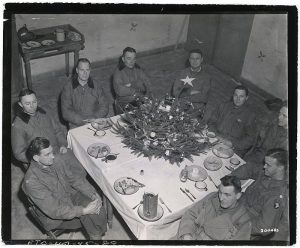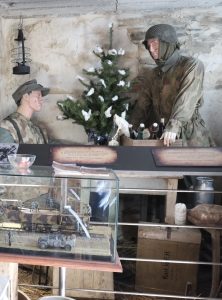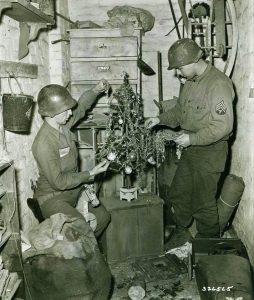Certain times of the year linked to ancient traditions seem even crueller to populations plunged in war. In our western countries of Christian culture, the winter period and especially Christmas rhymes with light, birth and renewal, truce and sharing. Notions or beliefs with distant origins. Here are some facts that took place in the Land of Memory, reported by many witnesses. They will freeze you or warm your heart.
In the Middle Ages, the Truce of God was established. It allowed to curb the aggressive impulses of the society and established the temporary stop of military operations during certain periods of the year. It was not forgotten at Christmas 1914…somewhere in the trenches in Belgium. A part of humanity is finally found. German and British soldiers decide to leave their trenches, share cigarettes, memories and…organize a soccer match. In the woods of Ploegsteert (Comines-Warneton), German soldiers set up candle-lit trees on top of their shelters and sang Christmas carols to which the British responded. These exchanges continued until January 1915, although any fraternization with the enemy was punishable. The fraternization recounted by Christian Carion in his film “Merry Christmas” was inspired by what took place in the trenches surrounding the town of Ypres.
Events immortalized today by a cross located at the memorial of Ploegsteert.
At Christmas 1914 in Gaume, men of the 5th army of Kronprinz Wilhelm of Prussia received a pipe whose earthenware stove was decorated with his effigy. In the same way, to the soldiers of the Yser at Christmas 1919, King Albert offers a leather pouch with his monogram and the inscriptions “Yser Noël 1916”.

In the sixteenth century in Alsace, the tradition was to decorate the tree with apples and hosts. From there, the custom developed in Germanic countries, and more particularly in the German bourgeoisie. German emigrants brought this custom to the Anglo-Saxon world in the 19th century. Germanic tradition which reappears in Belgium in 14. German soldiers tried to recreate the atmosphere of a Christmas Eve in the occupied country. Well known to the Allied troops (British and Americans), this custom was well perceived at the liberation in 1918. The tree became a symbol of peace. And a few decades later, in the middle of the Battle of the Bulge, civilians and combatants wanted to celebrate Christmas around an improvised tree.



The Christians of the 4th century chose the longest night of the year to celebrate the birth of Christ (Christmas comes from natalis dies: day of birth), light in the night according to their faith. During the Great War, traditions from Germany and Northern Europe were discovered, such as the Christmas wreath decorated with lighted candles from the beginning of Advent. To these rites is added the pleasure of composing the crib. The first living crib is attributed to Francis of Assisi in the 13th century. But it is in the 16th century that the cribs entered the homes. In 1918, Germans left in Gaume a crib of Lorraine tradition.

It is in the vicinity of Bastogne, in Champs, that a German officer delivers a poignant Christmas message during a tragic melee in December 44. In this village of the perimeter of Bastogne, the soldiers are going to confront each other from house to house. On Christmas Day, the ground was littered with corpses and the wounded were numerous. Here are a few snippets of what he wrote on the school board: “May the world never live such a Christmas night! Is it worthy of a human being to die with weapons, far from his children, his wife and his mother? It is from the ruins and the blood that universal brotherhood will undoubtedly be born.” A message that the teacher will discover in mid-January 1945 in his ruined school.

